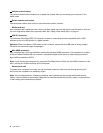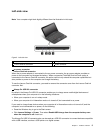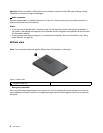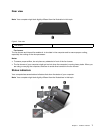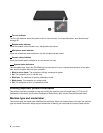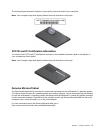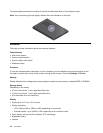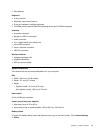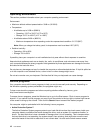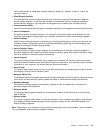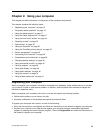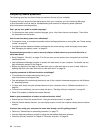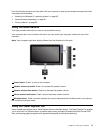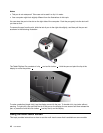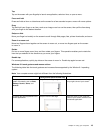
Operating environment
This section provides information about your computer operating environment.
Environment:
• Maximum altitude without pressurization: 3048 m (10 000 ft)
• Temperature
– At altitudes up to 2438 m (8000 ft)
– Operating: 5.0°C to 35.0°C (41°F to 95°F)
– Storage: 5.0°C to 43.0°C (41°F to 109°F)
– At altitudes above 2438 m (8000 ft)
– Maximum temperature when operating under the unpressurized condition: 31.3°C (88°F)
Note: When you charge the battery pack, its temperature must be at least 10°C (50°F).
• Relative humidity:
– Operating: 8% to 80%
– Storage: 5% to 95%
If possible, place your computer in a well-ventilated and dry area without direct exposure to sunshine.
Keep electrical appliances such as an electric fan, radio, air conditioner, and microwave oven away from
your computer because the strong magnetic elds generated by these appliances can damage the monitor
and data on the hard disk drive.
Do not place any beverages on top of or beside the computer or other attached devices. If liquid is spilled on
or in the computer or an attached device, a short circuit or other damage might occur.
Do not eat or smoke over your keyboard. Particles that fall into your keyboard can cause damage.
Lenovo programs
Your computer comes with Lenovo programs to help you work more easily and securely. Depending on
the Windows operating system preinstalled, the programs might vary.
To learn more about the programs and other computing solutions offered by Lenovo, go to:
http://www.lenovo.com/support
To access Lenovo programs, press the Windows key to go to the Start screen. Click a Lenovo program to
launch it. If you cannot nd the program you need, move the pointer to the top-right or bottom-right corner
of the screen to bring up the charms. Then click the Search charm to search the desired program.
You computer might be preinstalled with the following Lenovo programs.
• Active Protection System™
The Active Protection System program protects your hard disk drive when the shock sensor inside your
computer detects a condition that could damage the drive, such as system tilt, excessive vibration, or
shock. The hard disk drive is less vulnerable to damage when it is not operating. This is because when
the hard disk drive is not operating, the system stops it from spinning, and might also move the read
and write heads of the drive to areas that do not contain data. As soon as the shock sensor senses
12 User Guide



